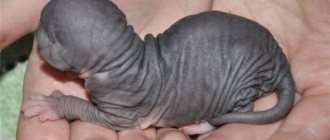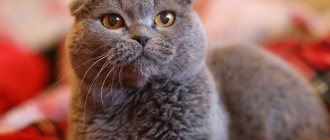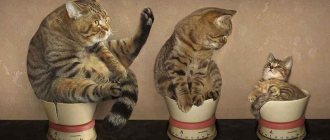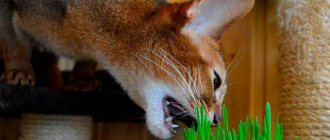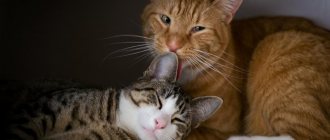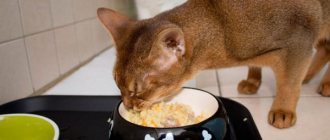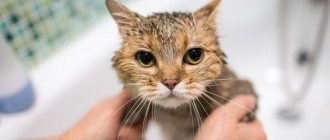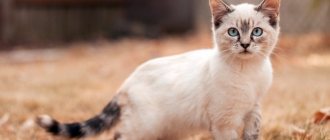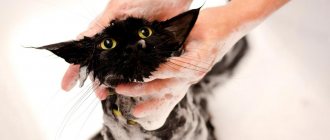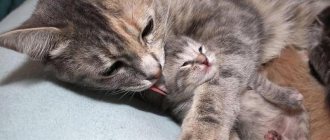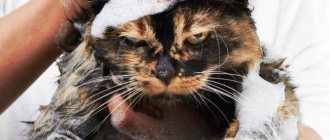To organize proper and complete care for animals, it is necessary to take into account their physiological characteristics in each period of growth. This will allow you to organize competent care, determine the timing of mating, and create a correct and complete diet. Let's figure out what age cats grow to and determine the factors that influence this process.
What is physiological growth
Physiological growth is the process of increasing body size and gaining muscle mass through continuous cell division. The answer to the question of how old cats grow is very ambiguous. The animal grows to the size required by its genetics and breed. For each age, there are certain norms for body size and weight, but there are also individual characteristics. Some physiological and external factors also influence the growth of animals.
In parallel with growth, the development of the cat’s body occurs, the formation and formation of all organs and systems. It is believed that furry pets grow and develop until puberty. Then, this process continues, but not so actively.
What affects the size of an animal
If you observe a kitten over a long period of time, you will notice that when it reaches the age of two years, the size of its muzzle and the width of its shoulders remain unchanged. This means that formation has completed and it is no longer growing.
First of all, a kitten’s growth is influenced by its genetics:
- The main factor is the breed of the animal. The larger it is, the more time passes before the end of growth;
- hormonal background and genetic predisposition;
- A mother cat's weight also affects how quickly her babies grow. The larger it is, the sooner the kittens will grow up;
- When using hormonal drugs, an imbalance of the endocrine system develops, which negatively affects growth.
Impact of environmental factors:
- if the kitten is not eating well, its growth time changes;
- the formation is influenced by the state of the place in which the animal is located;
- if pets are often stressed, their growth is impaired;
- if the pet was neutered late, this affects not only its weight, but also its height.
Factors influencing the growth and development of a kitten
The main role in regulating body functions (including growth function) belongs to the endocrine system, namely the pituitary gland. The anterior lobe of the pituitary gland produces the growth hormone somatotropin. This biologically active substance ensures the growth of bones and cartilage, and takes part in the formation of muscle mass. No less important is the general hormonal background, which is created by the work of the thyroid gland, reproductive system and adrenal cortex.
There are several other physiological factors that shape the body’s ability to actively grow:
- Breed characteristics. Cats of small breeds go through physical development somewhat faster than their large relatives.
- Belonging to one gender or the other. Males gain weight more actively.
- Hereditary characteristics. The kitten adopts its character and growth characteristics from its parents. You can understand what an animal will be like at the peak of its development by looking at its mother and father.
The rate of physiological growth of cats is greatly influenced by the external circumstances and conditions in which they live and are raised, as well as the characteristics of their care:
- Habitat. If kittens grew up in a cold climate, with few sunny days, then their metabolism was slowed down. This means that they will lag behind in development from their relatives, who have lived their entire lives in the south.
- Lifestyle. Domestic cats living in warm conditions, receiving enough food and all the nutrients they need, have good immunity and develop faster than street animals.
- Amount of sleep and rest. The cat needs to sleep enough time. If in childhood animals are playful and active, then in adulthood the normal amount of sleep for them should be 17-20 hours a day.
- Physical activity also plays a role in development. The animal must be given enough space and opportunities to play.
- Hereditary and acquired diseases. Owners must take all measures to protect their pets from possible infections. In this sense, the importance of preventive vaccinations cannot be overestimated.
- Early castration and sterilization significantly pushes the limit of active growth. After surgery, the rate of growth and weight gain decreases significantly.
- Early pregnancy has a similar effect. After its onset, the priority for the body becomes bearing and then feeding the offspring.
What can I do to make my cat get better?
First of all, understand the reasons for thinness. If the animal is healthy, you should pay attention to the diet.
On natural food
You should not feed your pet fatty foods. It will contribute to the increase in adipose tissue, which will make the cat bigger and heavier, but will be a colossal burden on the liver. A pet will gain weight faster and without risk to health when there is a lot of meat in its diet, and feeding will be carried out in small portions, several times a day.
To build muscle mass, you need proteins - animal and vegetable. For this purpose, it is recommended to give the cat:
- beef and offal. It is important that the meat is pre-frozen. Before feeding the pet, the product is allowed to thaw to room temperature;
It is recommended to include lean meat (beef) in your cat’s diet.
- cartilage broth;
- chicken meat, preferably breast. Despite all the benefits of chicken, you should not get carried away with it, so as not to provoke an allergy in your cat;
- eggs, preferably quail;
- bran and oatmeal in the form of porridge;
- boiled sea fish, boneless and in moderation;
- cream with less than 10% fat content;
- fermented milk products (kefir, yogurt, cottage cheese), which are also a source of calcium and also contribute to better digestion of food.
For weakened animals, special formulations for enhanced nutrition are recommended, which are sold in veterinary pharmacies in the form of powders and drops.
On ready-made food
In this case, everything is much simpler. As a rule, cats that eat premium food look healthy and well-fed. This is explained by the fact that the compositions are perfectly balanced and contain the entire complex of elements necessary for normal nutrition of the cat. Each manufacturer's line includes products for animals that take into account their age, health status and other characteristics.
We recommend reading: Antigadin for cats, composition and comparison of sprays: which one helps better, how to make it yourself?
to navigate the assortment and choose the right food . To do this, you need to know everything about your pet, down to its taste preferences, which will greatly simplify the task. Each food package contains detailed information about the composition of the product, as well as which cats and in what quantity it is best to give the product.
There are a huge number of ready-made cat foods.
As for economy segment feeds, they contain practically no meat. Cats that consume such food for a long time receive insufficient nutrition, which may have adverse effects on their health. Those who believe that the problem can be solved by feeding their pet chicken or cutlets are mistaken:
- firstly, food familiar to people is not always suitable for cats;
- secondly, you should strictly adhere to the chosen nutrition system. That is, you cannot feed the animal both “dry” and “natural” at the same time.
A cat's digestive system adapts to process certain types of food. Thus, dry food is digested easily and quickly, while natural food takes longer to digest. The combination of elements of both nutritional systems threatens serious eating disorders.
You can read more about what is best to feed a kitten: natural products or ready-made dry food here.
Stages of growing up
Growth limits for each animal are individual, but there are averages. It is known that the phase of most active development ends at the age of 10-15 months. Large breeds such as Britons continue to grow for some time after puberty. Small and medium breeds finish their development earlier. These include, for example, fold-eared and straight-eared Scots (medium breeds), and among small ones - munchkins.
There are several main stages of kitten development (starting from birth). In order for the baby to develop correctly and be in good health, it is important that favorable conditions are created for him at each stage:
- The neonatal period (lasts 4-7 days after birth) is a phase of continuous growth, although it is possible that the kitten will lose some weight during this period.
- The suckling period (lasts 3-3.5 weeks). Rapid weight gain phase. Kittens are rapidly increasing in size and learning to navigate independently.
- Transitional period (lasts from 4 weeks to 2 months). The first teeth appear. At this age, complementary feeding and transition to independent feeding are carried out. There is a significant leap in development.
- Adolescence (lasts until the end of active development). Phase of active and uniform growth. This is the period of formation of the skeletal and endocrine systems. It is important that the diet at this time is of high quality and complete.
Active formation of the bone apparatus lasts up to six months. For proper bone growth, the kitten must receive sufficient amounts of calcium and vitamin D during this period.
Cats stop growing by the age of 3, and cats already look like adult animals at 2 years of age. At this time, their ovaries activate. After the bone skeleton and muscle corset have completed their formation, an increase in body weight and size occurs only due to the accumulation of fat.
How to choose a kitten that will grow large?
First, you need to find a breeder of large-breed animals with extensive experience and a convincing reputation in order to purchase a suitable kitten from him. The animal must:
- be a purebred representative of your breed, which would be confirmed by metrics;
- have good health and vaccinations according to age. Notes about this should be looked for in veterinary documents;
- be at least two months old. Experts believe that for full development, a kitten must feed on mother’s milk up to this age;
It is advisable to choose a male animal, ideally the largest in the litter. It is worth paying attention to parents. Not all large breeds grow large and heavy. Heredity in this matter is one of the determining factors.
When choosing a kitten, the future owner's eyes widen
Then everything is simple. You should take proper care of your pet and feed it well, not allow it to wander on its own, and also contact the clinic in a timely manner if your pet gets sick.
Providing ideal conditions for development
The first five months of a kitten's life are especially important. This period determines how actively and qualitatively their future life will be. The owner must do everything to ensure that the development of the small organism proceeds correctly. Proper care is of great importance. During this period, the conditions in which kittens grow must be ideal:
- Stable air temperature (about 20 degrees Celsius) and humidity (about 55%).
- Maintaining hygiene. The cat's nest should be cleaned regularly. At the bottom there should be a special bedding that absorbs urine, liquid feces and traps pathogens.
- Protection from parasites. The first deworming should be done at the age of 8 months. Constant protection against skin parasites, fleas and ticks is also important.
- When transferring to independent feeding, it is necessary to ensure that the kitten’s diet is rich in vitamins and balanced in the amount of nutrients and microelements.
What to do if the cat continues to grow
There are also opposite cases, the cat continues to grow, despite the fact that it has already crossed all age limits.
In this case it is necessary:
- understand the reasons for this phenomenon;
- put the animal on a diet;
- limit your diet to high-carbohydrate foods;
- encourage the cat to lead an active lifestyle;
- consult a veterinarian.
In order for a pet to grow properly, it is necessary to create favorable conditions for it: feed it with balanced food containing vitamins; maintain a temperature of at least 20 °C; from time to time, give anthelmintic drugs and fight skin parasites. Only then will the pet feel great.
Reasons for slow growth in kittens
There are several reasons why the active growth and development of kittens in the first important year of life can be significantly slowed down. Here are the main ones:
- Insufficient or inadequate nutrition. In the first months of life, the kitten may not have enough mother's milk. When transferred to independent feeding, he may suffer from a monotonous and incorrectly selected diet, poor in vitamins and minerals.
- Hereditary deviations. If the kitten’s parents suffered from genetic pathologies, then the likelihood that they will be passed on to the baby is very high. Correcting such deviations is difficult, and in many cases it is not possible.
- Hormonal imbalances. The main cause of hormonal imbalance at a young age is early sterilization or castration. Usually, the body of a kitten that has survived such an operation stops developing for some time. Over time, this process is restored.
- Viral and infectious diseases. An infectious disease often causes complications in the stomach or intestines. This affects the absorption of food and microelements necessary for growth.
- Helminthic infestations. Parasites take away a significant portion of the nutrients that come from food, so even with a good appetite, the baby becomes thin and slows down its growth. Preventive quarterly deworming is a salvation.
Causes of delayed development
Very often, owners of purring pets are forced to consult a specialist about slow growth. Every owner can face this problem. The size of a cat primarily depends on heredity and genes. But that's not all. In order for the genetic code that is responsible for the growth of a kitten to be fully realized, it is necessary to create favorable external conditions for it.
A kitten's development may slow down for the following reasons.
- The food does not meet the norms and requirements. Although the kitten may look well-fed and well-fed, its growth does not correspond to the norm. When he grows intensively, his body needs good nutrition, and it is important that the food he eats is of high quality in composition. The food that is present in the animal’s diet must contain vitamins, calcium, phosphorus, and protein. In this case, it is important to take into account both the breed and age of the kitten. Not only your appearance, but also the state of your immune system depends on proper nutrition.
- Various diseases. It is very important to ensure that the kitten does not contract various infectious diseases to which the baby is most susceptible during intensive growth. It is necessary to carry out the necessary vaccination and treatment in a timely manner. One of the main reasons why an animal stops growing is the appearance of helminthic infestations.
- Hormonal disbalance. In this case we are talking about castration, which applies to cats, and about sterilization, which cats undergo. Therefore, before you decide to take such a step and submit your pet to this procedure, be sure to consult with a specialist to make sure that this kind of intervention will not harm the animal.
This leads to the conclusion that if you suddenly notice that your pet is stunted, you need to:
- first of all, go to the doctor;
- diversify your diet;
- carry out parasite prevention according to the recommendations of a specialist.
British breed from the breed and the British breed Codes of breeds cats kittens Elite Development of kittens occurs growth of kittens weight of kittens behavior of kittens when kittens open growth of kittens size of kittens development of kittens from size of kittens growth of a cat and the size of a cat and the size of a cat will Development of a cat and differ cat wrong cats are more curious box cat (or cats will Feeding a cat cat stands out British cats kittens nursing cat cats completely on cats - British cats for cats and British cats and British cats for cats in cats British kitten growth of a kitten is considered the development of a kitten for the development of a kitten (kitten development calendar) growth raise a kitten to the age of the kitten if
dog article site question animals teeth matter comment behavior features day agreement
Ways to enhance the growth and development of kittens
A veterinarian will help determine the cause of slow growth and development. If these are endocrine disorders or hormonal imbalances, the doctor may prescribe injections of drugs that normalize metabolism and stimulate accelerated growth. These include kartinina chloride (growth vitamin), Gamavit, Milgamma (vitamin B complex).
A kitten that is lagging in growth and development must be surrounded with care and attention. It has been proven that an animal that is loved, caressed, praised and stroked grows well and gains weight.
Why is my pet growing very slowly?
A situation often arises when the owner notices that his pet is significantly inferior in height to other purebred brothers. Slow growth of an animal is usually an alarming sign, indicating the development of certain diseases and pathological processes in the body, both congenital and acquired. Factors slowing down growth:
- Pet care and habitat. The most important and fundamental factor due to which a cat grows slower is improperly organized nutrition. If your pet's diet is deficient in vitamins and minerals, the body will not have enough of these nutrients to grow. In this case, you need to contact a veterinarian so that a specialist can select the right diet to compensate for the lack of vitamins and nutrients. Often in this case, industrially produced food is prescribed for nutrition. A kitten taken into the house from the street should also be fed with ready-made fortified industrial rations.
- Hormonal imbalance. This pathology occurs mainly in those cats that have been castrated. When there is a hormonal imbalance, growth slows down for some time, after which the body fills this gap with active growth.
- The presence of parasites in the body. If a cat is found to have worms, the body will devote all its energy to maintaining performance, so all the nutrients and vitamins supplied with food do not have time to be absorbed. To restore your pet's growth, you need to cure it of parasites, and then carry out maintenance therapy with plenty of vitamins and nutrients. Cats need preventative worming every 3 months to protect them from parasite infection.
- Long-term use of hormonal drugs. These drugs negatively affect the endocrine system.
- Passive lifestyle. If a cat moves little, its muscular system stops developing, blood circulation is impaired, and concomitant diseases, such as diabetes, may occur.
- Viral or infectious diseases suffered at the peak of physical development (5-6 months).
In addition, diseases such as diabetes mellitus and the development of cancer can also slow down growth. Therefore, if the owner notices that his pet has begun to lag behind in physical development, it is recommended to undergo timely diagnosis and treat the diseases and pathologies found.
Early mating is one of the reasons for the slowdown in growth of both females and males. The pet may stop growing altogether. In addition, early mating can result in the development of absolute infertility.
Features of growth of large breeds
There are several artificially bred cat breeds, the representatives of which are particularly large in size. The most common of them are the following:
- Maine Coons;
- Bengal breed;
- British breed.
Let's look at the age at which large breed cats grow, and what size they can reach with good care.
Bengal breed
Kittens are born very small, their weight does not exceed 120 grams. During the first month of life, kittens gain weight up to 500 grams. Then active development stops, and by the age of 3 months the weight is a little more than one kilogram. At 7 months the process slows down even more, but continues to progress. Animals gain the bulk of kilograms in the first two years of their existence. Regular cats weigh 7-8 kg at 5 years old, while castrated cats can reach 10 kg.
Maine Coons
The weight of a newborn Maine Coon can be 170 grams. By gaining 10 grams in weight every day, a kitten aged 10 days becomes 2 times heavier, by 28 days - 4 times heavier, and by 8 weeks - 8 times heavier. At the age of 4-5 months, the kitten's peak growth activity occurs. At this time, its energy costs are greatest. Bone growth continues for up to 1.5 years, after which muscle mass develops and the animal grows in breadth. A cat reaches its peak of development at the age of 3-5 years. At this time, his weight can increase to 10 kg.
Signs of proper animal development
It is known that kittens are not fully developed after birth. Their ears and eyes are closed, the muscles of their limbs are not developed, and they can only crawl. The first week of life after the birth of a kitten is called the neonatal period. The mother is constantly in the nest and does not leave the newborns. The baby's body weight during the neonatal period can increase or decrease, and this largely depends on lactation.
Then the suckling period begins, when babies grow rapidly and gain weight. At this time, amazing changes occur to them. With proper care and proper nutrition, babies increase their weight 4 times in the first month. Their tail grows, ears form and their eyes open. They leave the nest and exercise their legs.
During the suckling period, babies grow rapidly and gain weight.
By the age of 4 weeks, kittens' first teeth have erupted and they begin to feed themselves. This begins a new period, which is needed to adjust the endocrine system, which triggers the active growth phase. During this period of time, the mother’s lactation ends, and the type of feeding the pet changes. Now it becomes a concern for the animal owner. The kitten must be provided with a large amount of calcium necessary for bone growth.
Attention! Changing the feeding regimen and switching to a different type of food can affect the decrease in the baby’s growth rate and weight.
After the baby gets used to the new diet, and the internal secretion organs regulate metabolic processes, the growth of skeletal bones will accelerate. This happens towards the end of the second month.
At 4 weeks, kittens begin to erupt their first teeth.
The following will stimulate rapid growth in kittens:
- Constant air temperature of at least 20 °C.
- Humidity at 55%.
- Absorbent bedding in the nest.
- Anthelmintic treatment at 8 months of age.
- Fight against fleas and other skin parasites.
- Fortified balanced diet.
The most active period for bone growth is the time from 3 months to six months. At this time, the endocrine system produces many hormones necessary for the growth of skeletal bones and internal organs.
The growth of teeth can also be an indicator of the proper development of the animal. A normally developing kitten at 2 months has all its baby teeth. On the upper jaw you can see 6 small incisors, 2 canines, 3 premolars. On the lower jaw there are the same number of incisors, canines and molars, and there are only 2 premolars. The third pair will grow when milk teeth are replaced by molars. This will happen at 5 months of age or a little older. First, the incisors will be replaced, then the canines, then the premolars will come. The molars are replaced with the latest ones. After a complete replacement, the cat will have 30 teeth, but this does not mean that skeletal growth will stop after that.
After a complete replacement, the cat will have 30 teeth
How tall are cats when they stand up?
If you're wondering how high your cat can climb while standing on her hind legs, you'll need to consider the length of her front, back, and back legs. Consider, for example, a Savannah cat. These cats can be almost twice the height of the average domestic cat, and by stretching out on their hind legs, they can reach considerable distances.
A large Savannah cat can be 20 inches (50.8 cm) long, and its legs can be about 14 inches (35 cm) long. If you add up the length of the back from tail to neck and the length of the front and hind legs, you can estimate how high they can climb.
If a cat of this size stood on her hind legs, she would be able to reach something almost 48 inches (121.5 cm) high with her paw. This is the ability to reach four feet off the ground without jumping! To put this measurement into perspective, a standard kitchen counter is 36 inches (91.44 cm) high.
Obviously, the average house is not a Savannah cat, so to find out how tall your cat is on her hind legs, you'll have to get out the measuring tape and do a little math.
Tallest cat breeds
There are several impressively tall (and large) cat breeds in the world, and we're not even discussing wild ones. In case you were wondering, the tallest living cat is Hercules, a lion-tiger hybrid who stands 49 inches (1.25 m) tall at the shoulders. When it comes to domestic cats, here are some of the tallest breeds:
Maine Coon
Maine Coons are one of the largest cat breeds, although they are not always the tallest. They typically stand between 10 to 16 inches (25.4 to 40.6 cm) in height, which is impressive, but not as impressive as their length. Male Maine Coons often reach a length of 30 inches (76 cm) from nose to base of tail. The tail can easily add another 15 inches (38 cm) in length.
Savannah
In this article we have repeatedly mentioned the Savannah cat, and for good reason. These cats are a cross between a domestic cat and a serval, a non-domestic wild cat. The serval is a medium-sized wild cat with cheetah-like markings. The Serval is native to Africa and first mated with a domestic cat in 1987, resulting in the world's first (known) Savannah cat.
Most closely related to their Serval ancestors, Savannah cats are typically the largest, inheriting their height, diet, and independence. The tallest Savannah cat ever recorded was Arcturus Aldebaran Powers of Southfield, Michigan, who stood over 19 inches (48.26 cm) tall and could easily climb over the kitchen counter in his home.
Norwegian forest cat
The Norwegian Forest Cat is a gorgeous, thick-haired cat that thrives in cold temperatures thanks to its thick coat and healthy size. These cats average 9 to 12 inches (22.8 to 30.5 cm) in height, which is not as tall as a Savannah, but larger than a typical domestic cat.
Chausie
Like the Savannah, the Chausie is another hybrid cat; It is a mixture of a domestic cat and a wild cat, a jungle cat. Chausies appeared after the savannahs, which were purposefully bred in 1990, and are comparable in size to them. The average height of the Chausie is 14 to 18 inches (35.5 to 45.7 cm).
Bengal cat
The Bengal cat is the third hybrid cat on this list, this time a mix between a domestic shorthair cat and an Asian leopard cat. Bengals have been bred longer than Savannahs, with targeted breeding beginning in 1963. Bengals can reach 16 inches (40 cm) in height.
Content recommendations
The answer to the question of how long cats grow depends largely on proper care. Owners need to create the most suitable conditions for their pets. First of all you need to:
- Maintaining hygiene is no less important for cats than for people. The pet must always be clean and well-groomed. Once a month, the cat needs to be bathed and thoroughly brushed. The cat's litter box should be emptied regularly and the filling should be changed, and the food bowl should be thoroughly washed several times a week.
- Once a quarter, helminthiasis prevention should be carried out. This is done with the help of special drugs. You can find out the exact name and dosage from your doctor.
- If the animal suffers from any chronic disease, it is necessary to regularly see the veterinarian. Take courses of treatment or prevention as prescribed.
- Comprehensive vaccinations against feline infections need to be updated annually. Thanks to this measure, the cat’s risk of contracting a viral, bacterial or fungal infection is reduced. This also applies to pets who do not leave the apartment. Owners can bring the infectious agent on shoes or clothing.
- Proper nutrition plays an important role. There are special cat foods with vitamin and mineral supplements on sale. If the animal eats natural products, medications are purchased separately.
- You should not expose your cat to unnecessary stress - yell at him, physically punish him, etc. Jealousy has a bad effect on the animal’s psyche.
- Early mating will not benefit the cat's health. If a pet becomes pregnant before a year, she may experience hormonal imbalances and developmental arrest. The female’s body will devote all its strength to bearing offspring, and the cat herself may become seriously ill or die from exhaustion.
Compliance with these conditions will help raise a healthy and strong animal that will delight the owner for many years.
